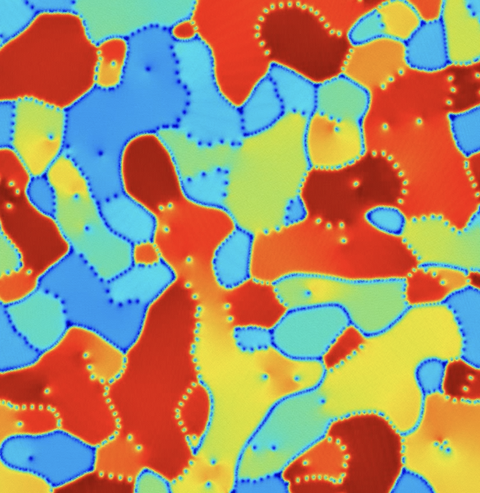Aug 30, 2024
Material science: New understanding of grain boundary kinetics unlocks advanced control of crystal microstructures

Darstellung einer Phasenfeld-Kristallsimulation, die die Mikrostrukturentwicklung eines Polykristalls in zwei Dimensionen wiedergibt.
An international research team provides new concepts for manipulating polycrystalline materials by shedding new light on fundamental mechanisms of grain boundary motion. They demonstrate that grain boundaries in crystalline materials move like Brownian ratchets, meaning that non-equilibrium perturbations like oscillating stress or temperature can drive their directional motion and thus accelerate microstructure evolution and grain growth. Their findings have now been published in the renowned journal “Science”.
Crystalline materials in nature and technology, such as metals, ceramics, colloids, and rocks, are mostly polycrystalline and are exploited in a wide range of applications, from microelectronics to structural components in aerospace and construction. When a material is polycrystalline, it means that it consists of many different crystals with different orientations, often also referred to as grains. These grains are characterized by well-arranged atoms in a lattice structure, and extended defects or interfaces form between them, which are called grain boundaries. Those grain boundaries are common in crystals and profoundly influence their mechanical and physical properties. Therefore, manipulating the distribution of grain boundaries and the resulting microstructure is a key strategy for tailoring material properties.
An international research team, including Prof. Marco Salvalaglio and the PhD student Maik Punke from the Institute of Scientific Computing at TUD Dresden University of Technology, was now able to demonstrate that non-equilibrium perturbations such as oscillating stress or temperature can drive directional motion of grain boundaries and thus accelerate grain growth. Their work shows that most boundaries move in a way that is similar to so-called “Brownian ratchets”, which are mechanisms that convert random fluctuations into directed motion.
The team obtained these results by using advanced simulations leveraging different methods as well as experiments. They reshaped our fundamental understanding of how boundaries move in crystals and provided new concepts for manipulating polycrystalline materials.
“With our findings, we reshaped the current understanding of grain boundary kinetics, held by most researchers and textbooks. Besides its fundamental importance, this research has important implications for microstructure control in materials. Elimination of grain boundaries and acceleration of grain growth can be achieved by applying oscillatory fields like stress, temperature, as well as electric and magnetic fields. This concept may find several applications in the development of materials with enhanced strength and resistance to temperature, as well as in tailoring grain boundary distributions. Our work is very interdisciplinary, relating basic research from the Faculty of Mathematics to state-of-the-art research with practical applications in Material Science and Engineering,” states Marco Salvalaglio.
Next to Prof. Marco Salvalaglio from TUD, the collaboration consisted of researchers from CityU Hong Kong, the University of Hong Kong, the University of California, and the Shanghai Jiao Tong University.
Original publication:
Caihao Qiu, Maik Punke, Yuan Tian, Ying Han, Siqi Wang, Yishi Su, Marco Salvalaglio, Xiaoqing Pan, David J. Srolovitz, Jian Han. Grain boundaries are Brownian ratchets. Science, Vol 385, Issue 6712, pp. 980-985. DOI: 10.1126/science.adp1516
Contact:
Prof. Dr. Marco Salvalaglio
Institute of Scientific Computing
TUD
Dresden Center for Computational Materials Science
Tel.+49 351 463-35657
Email:
